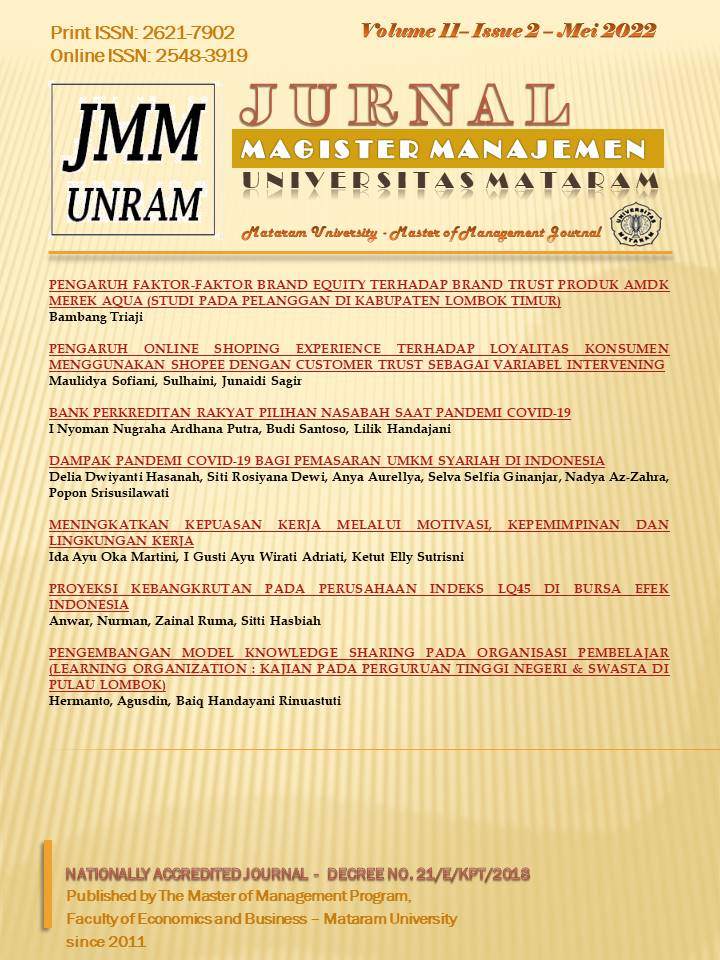BANK PERKREDITAN RAKYAT PILIHAN NASABAH SAAT PANDEMI COVID-19
DOI:
https://doi.org/10.29303/jmm.v11i2.713Abstract
This study aimed to analyze the differences in profitability and operational efficiency before and during the COVID-19 pandemic in rural banks. It is interesting, and when all industries experience a decline, BPRs can still survive by posting positive profits. This quantitative research with a comparative research type compares the profitability and efficiency of Rural Banks (BPR) in West Nusa Tenggara before and during the pandemic. The output is essential in providing model recommendations so that BPRs in NTB survive during a pandemic and can continuously serve the community and MSMEs in alleviating poverty according to the leading areas of poverty alleviation and the top topic of the study of capital schemes. The research location is at Rural Banks in West Nusa Tenggara (NTB) Province from the end of 2019 to mid-2020. The analytical tool used is the t-test (differentiation test) of 2 paired samples. This research shows the ability of BPRs to survive and generate profits during a pandemic.References
______________, 2020, Statistik Perbankan Indonesia, Otoritas Jasa Keuangan, Nopember.Jakarta.
Ally, Z., 2013, Comparative Analysis of Financial Performance of Commercial Banks in Tanzania, Research Journal of Finance and Accounting, Vol.4, No.19, pp. 133-144
Amri, A., 2020, Dampak COVID-19 Terhadap UMKM di Indonesia, Jurnal BRAND, Vol. 2, No.1, pp. 123-130
Divini, Aikaterini dan Nikos Schiniotakis, 2015, Performance and profile: a twofold bank profitability riddle, Team Performance Management, Vol. 21 No. 1/2, pp. 51-64.
El Masah, S., dan O. Al-Sayed, 2015, Banking Sector Performance: Islamic And Conventional Banks In The UAE, International Journal of Technology Information and Business Management, Vol.36 no.1, pp. 69-81.
Fendel, R., Neugebauer, F., and Zimmermann, L., 2020, Reactions of euro area government yields to Covid-19 related policy measure announcements by the European Commission and the European Central Bank, Finance Research Letters, Vol.xxx, No.xxx, pp. 1-5.
Helhel, Y., 2015, Comparative Analysis of Financial Performance of Foreign and Domestic Banks in Georgia, International Journal of Finance and Accounting, 4(1): pp. 52-59.
Krieger, K., Mauck, N and Pruitt, S.W., 2020, The impact of the COVID-19 pandemic on dividends, Finance Research Letters, Vol.xxx, No.xxx,
Mathew, N.G., dan L.A. Esther, 2012, A Financial Performance Comparison of Foreign VS Local Banks in Ghana, International Journal of Business and Social Science, Vol. 3 No. 21, pp. 82-87.
Megeid, N.S.A., 2017, Liquidity risk management: conventional versus Islamic banking system in Egypt ", Journal of Islamic Accounting and Business Research, Vol. 8 Iss 1, pp. 1-30
Menicucci, E., dan G. Paolucci , (2016),"The determinants of bank profitability: empirical evidence from European banking sector", Journal of Financial Reporting and Accounting, Vol. 14 Iss 1
Prabu, G.G. dan G. Chandrasekaran, 2015, A Comparative Study on Financial Performance of State Bank of India and ICICI Bank, International Journal of Research in Business Management, Vol. 3, Issue 4, Apr 2015, pp.19-26
Pratiwi, M.I., 2020, Dampak COVID-19 Terhadap Perlambatan Ekonomi Sektor UMKM, Jurnal Ners, Volume 4 Nomor 2, pp.30-39.
Rana, M, M.K. Hossain, dan R.S. Rekha, 2016, Profitability and liquidity of conventional banking and Islamic banking in Bangladesh: A comparative study, International Journal of Applied Research, no. 2(9), pp. 318-327.
Rosita, R, 2020, Pengaruh Pandemi COVID-19 Terhadap UMKM di Indonesia, Jurnal Lentera Bisnis, Vol.9, No.2, pp. 109-120.
Supeno, W. dan Hendarsih, I., 2020, Kinerja Kredit Terhadap Profitabilitas BPR Pada Masa Pandemi COVID-19, Jurnal AKRAB JUARA, Vol. 5, No.2, pp. 147-161.
Zheng, C. and Zhang, J., 2020, The impact of COVID-19 on the efficiency of microfinance institutions, International Review of Economics and Finance
Downloads
Published
How to Cite
Issue
Section
License
Copyright (c) 2022 I Nyoman Nugraha Ardhana Putra

This work is licensed under a Creative Commons Attribution 4.0 International License.
- Authors retain copyright and grant the journal right of first publication with the work simultaneously licensed under a CC BY-SA 4.0 (Creative Commons Attribution-ShareAlike 4.0 International). This license allows authors to use all articles, data sets, graphics, and appendices in data mining applications, search engines, web sites, blogs, and other platforms by providing an appropriate reference. The journal allows the author(s) to hold the copyright without restrictions and will retain publishing rights without restrictions.
- Authors are able to enter into separate, additional contractual arrangements for the non-exclusive distribution of the journal's published version of the work (e.g., post it to an institutional repository or publish it in a book), with an acknowledgment of its initial publication in JMM.
- Authors are permitted and encouraged to post their work online (e.g., in institutional repositories or on their website) prior to and during the submission process, as it can lead to productive exchanges, as well as earlier and greater citation of published work (See The Effect of Open Access).










